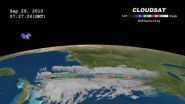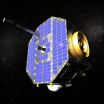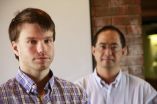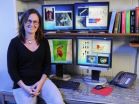(Press-News.org) For the first time, scientists are using advanced technology and an innovative vessel to study, image, and map the unexplored offshore Northern San Andreas Fault from north of San Francisco to its termination at the junction of three tectonic plates off Mendocino, Calif.
The team includes scientists from NOAA's National Marine Fisheries Service, Oregon State University, the California Seafloor Mapping Program, the U.S. Geological Survey and Woods Hole Oceanographic Institution. The expedition which concludes Sunday is sponsored by NOAA's Office of Ocean Exploration and Research.
While the fault on land is obscured by erosion, vegetation and urbanization in many places, scientists expect the subsea portion of the fault to include deep rifts and high walls, along with areas supporting animal life. The expedition team is using high-resolution sonar mapping, subsurface seismic data and imaging with digital cameras for the first-ever three-dimensional bathymetric-structural map that will model the undersea Northern San Andreas Fault and its structure. Little is known about the offshore fault due to perennial bad weather that has limited scientific investigations.
"By relating this 3-D model with ongoing studies of the ancient record of seismic activity in this volatile area, scientists may better understand past earthquakes — in part because fault exposure on land is poor, and the sedimentary record of the northern California offshore fault indicates a rich history of past earthquakes," said Chris Goldfinger, co-principal investigator and marine geologist and geophysicist at Oregon State University in Corvallis, Ore. "The model will also benefit geodetic studies of the buildup of energy to help better understand the potential for earthquakes."
More than a century after the 1906 Great San Francisco Earthquake, the science team is also exploring the fault for lessons associated with the intertwined relationships between major earthquakes and biological diversity. Evidence shows that active fluid and gas venting along fast-moving tectonic systems, such as the San Andreas Fault, create and recreate productive, unique and unexplored ecosystems.
"This is a tectonically and chemically active area," said Waldo Wakefield, co-principal investigator and a research fisheries biologist at NOAA's Northwest Fisheries Science Center in Newport, Ore. "I am looking for abrupt topographic features as well as vents or seeps that support chemosynthetic life — life that extracts its energy needs from dissolved gasses in the water. I'm also looking at sonar maps of the water column and images of the seafloor for communities of life."
A variety of sensors and systems are being used to help locate marine life including a NOAA autonomous underwater vehicle (AUV) named 'Lucille.' Elizabeth Clarke, a NOAA fisheries scientist, is coordinating Lucille's operations and obtaining photographic information about fauna associated with the fault. The AUV and its sensors can dive to nearly one mile (1,500 meters), but depths associated with this expedition will range between approximately 230 to 1100 feet (70 to 350 meters).
Early in the expedition, scientists collected bathymetric and subsurface seismic reflection data to guide them to specific areas of interest for follow-on and more detailed operations. The AUV's high-definition cameras are obtaining multiple images to be stitched into "photo mosaics" showing detailed fault structure and animal life.
The first part of the expedition is operating from Research Vessel Derek M. Baylis, a "green" research vessel primarily powered by sail and owned by Sealife Conservation, a nonprofit organization. The expedition will track the carbon footprint of the 65-foot energy efficient Baylis and compare results to conventional vessels.
AUV operations are being conducted aboard the Research Vessel Pacific Storm, operated by Oregon State University's Marine Mammal Institute. The ship and AUV team joined the expedition offshore of Fort Bragg on Sept. 25.
As the expedition progresses, NOAA's Ocean Explorer website features maps and images of the fault and associated ecosystems, logs from scientists at sea, and lesson plans that align with National Science Education Standards at three grade levels.
###NOAA's Office of Exploration and Research uses state-of-the-art technologies to explore the Earth's largely unknown ocean in all its dimensions for the purpose of discovery and the advancement of knowledge.
NOAA's mission is to understand and predict changes in the Earth's environment, from the depths of the ocean to the surface of the sun, and to conserve and manage our coastal and marine resources. Visit us on online or at Facebook.
On the Web:
NOAA's Office of Ocean Exploration and Research:
http://oceanexplorer.noaa.gov
Sealife Conservation:
http://sealifeconservation.org/baylis.html
Oregon State University's Marine Mammal Institute:
http://mmi.oregonstate.edu/research-vessels
California Seafloor Mapping Program:
http://walrus.wr.usgs.gov/mapping/csmp/
END
TORONTO, Sept. 30, 2010 – A waterproof controller designed and built by York University researchers is allowing an underwater robot to go "wireless" in a unique way.
AQUA, an amphibious, otter-like robot, is small and nimble, with flippers rather than propellers, designed for intricate data collection from shipwrecks and reefs.
The robot, a joint project of York, McGill and Dalhousie universities, can now be controlled wirelessly using a waterproof tablet built at York. While underwater, divers can program the tablet to display tags onscreen, similar to barcodes read ...
NANO -- World's smallest antenna . . .
Instead of the conventional long piece of metal or dipole antenna, electronic devices of tomorrow could incorporate an antenna no bigger than a gnat. This is made possible by a design that allows an electrically charged nano-mechanical oscillator to be tuned to specific electromagnetic waves. "Gone will be the days when we need to match the antenna length to the wavelength," said Panos Datskos, a co-developer of this proprietary technology. The potentially revolutionary system detects very small electric fields over large frequency ...
High in an alpine meadow, Gesine Pufal, from the University of Wellington, New Zealand, crouched low to the ground and splashed some water from her water bottle on a low green plant cushion, then sat back waiting to see if something would move. Sound crazy? Many hikers passing by her may have thought so, but Pufal was trying to find potential plant species that possess a type of plant movement called hygrochasy.
Although the ability to move is typically thought to be a characteristic unique to the animal kingdom, plants are also capable of movement, from the sudden ...
Tropical Storm Nicole was a tropical storm for around 6 hours before it weakened into a remnant low pressure area and is now off the Florida coast. NASA Satellite imagery captured different views of Nicole's clouds as the system weakened back into a low pressure area.
While Nicole weakened, a huge trough of low pressure over the U.S. eastern seaboard from Florida to Maine has become the key weathermaker there. The trough, an elongated area of low pressure, is streaming tropical moisture from Nicole's remnants and the Gulf of Mexico, bringing high rainfall totals and severe ...
A new study, derived from novel sleep research conducted by University of California, San Diego researchers 14 years earlier, suggests that the secret to a long life may come with just enough sleep. Less than five hours a night is probably not enough; eight hours is probably too much.
A team of scientists, headed by Daniel F. Kripke, MD, professor emeritus of psychiatry at UC San Diego School of Medicine, revisited original research conducted between 1995 and 1999. In that earlier study, part of the Women's Health Initiative, Kripke and colleagues had monitored 459 women ...
When NASA launched the Interstellar Boundary Explorer (IBEX) on October 19, 2008, space physicists held their collective breath for never-before-seen views of a collision zone far beyond the planets, roughly 10 billion miles away. That's where the solar wind, an outward rush of charged particles and magnetic fields continuously spewed by the Sun, runs into the flow of particles and fields that permeates interstellar space in our neighborhood of the Milky Way galaxy.
No spacecraft had ever imaged the collision zone, which occurs in a region known as the heliosheath, because ...
VIDEO:
See a time-lapse series showing hyper-replication of Salmonella bacteria (red) in epithelial cells from two to seven hours after infection.
Click here for more information.
New findings by National Institutes of Health scientists could explain how Salmonella bacteria, a common cause of food poisoning, efficiently spread in people. In a study published this week in the Proceedings of the National Academy of Sciences, researchers describe finding a reservoir of rapidly ...
A cheetah lies still in the grass. Finally, a gazelle comes into view. The cheetah plunges forward, reaches sixty-five miles per hour in three seconds, and has the hapless gazelle by the jugular in less than a minute. Then it must catch its breath, resting before eating.
A blue whale surfaces, blasting water high from its blowhole. It breathes in great gasps, filling its thousand-gallon lungs with air. Then it descends again to look for krill, staying below for 10, 20, even 30 minutes before taking another breath.
Both animals need oxygen, of course. And both depend ...
Ames, Iowa - An Iowa State University researcher searched for new genes that are turned on during infection in a type of mosquito that is not only a pest, but transmits disease-causing pathogens.
Lyric Bartholomay, assistant professor of entomology, along with colleagues from around the world, infected the common southern house mosquito (Culex quinquefasciatus) with various pathogens to see which mosquito genes are activated in response to the infection.
Bartholomay is the first author on the paper, "Pathogenomics of Culex quinquefasciatus and Meta-Analysis of Infection ...
DARIEN, IL – A study in the Oct. 1 issue of the journal Sleep found that getting too little or too much sleep in early pregnancy is associated with elevated blood pressure in the third trimester. The study suggests that improving prenatal sleep hygiene may provide important health benefits.
Results show that the mean systolic blood pressure in the third trimester was 114 mm Hg in women with a normal self-reported nightly sleep duration of nine hours in early pregnancy, 118.05 mm Hg in women who reported sleeping six hours or less per night, and 118.90 mm Hg in women ...



